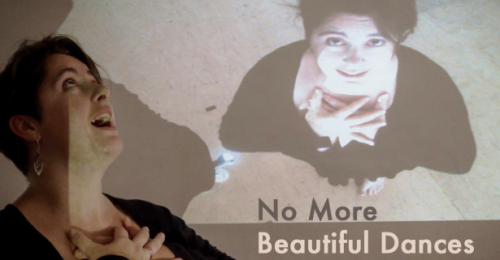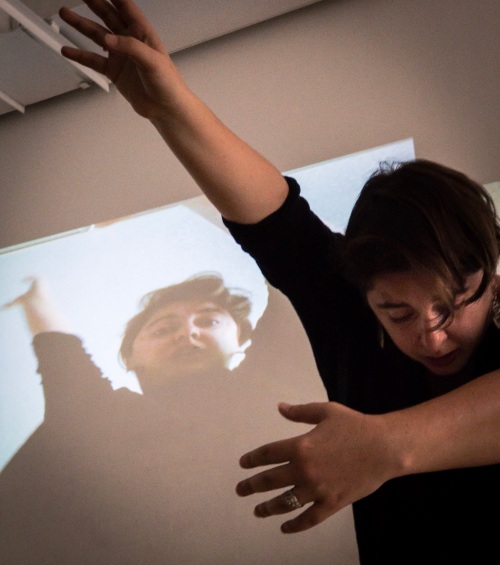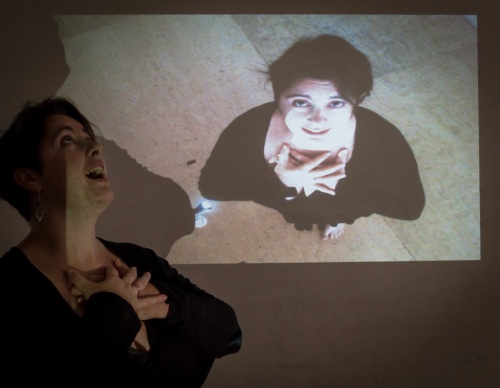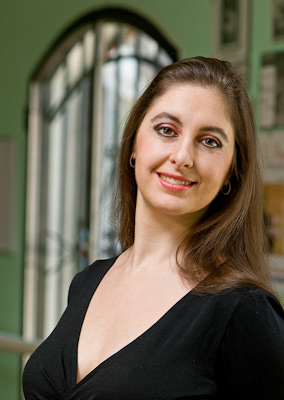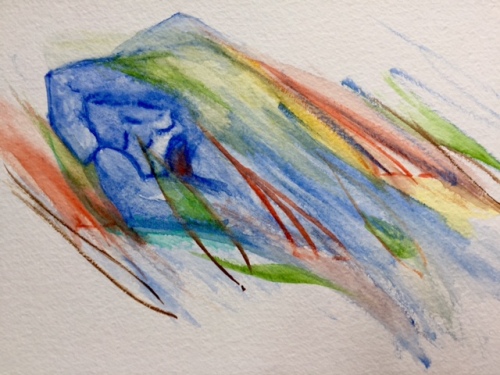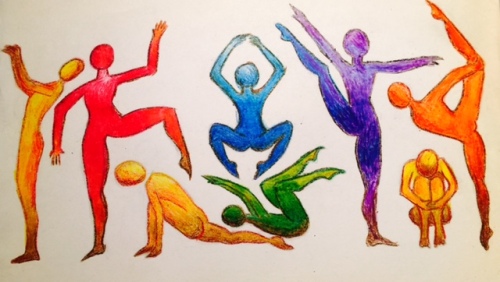- As a writer, sharing my point of view of life with others is my duty and my pleasure.
- As an educator, my perennial goal is to generate appreciation for and understanding of the arts and of artists.
- As a choreographer, I investigate the interior logic of performance and the role of a dancer in our culture today, redefining the parameters of dance and theater.
My work reflects my experience as a Latina/European artist living in New York and comes from a deep examination of my motivations as a woman, mother, and immigrant.
My aim is to integrate mind + body + spirit. That’s why I write, choreograph & teach.
Anabella Lenzu
In May 2017, I had the pleasure to interview Rajika Puri in Manhattan, after the show Celebrating INDIAN DANCE in AMERICA produced by Tina Croll and Jamie Cunningham’s FROM THE HORSE’S MOUTH and curated by Rajika at 14th Street Y, on April 29th.
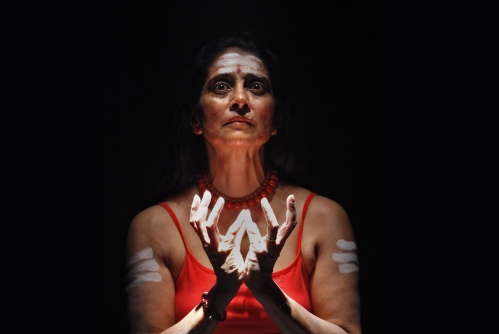 Tapasya: Ascetic Power and Tales of the Ganges (2009, Joyce SoHo) – Story of ‘Amrita’ told by Rajika as ‘1000 yr old Ravana’ (antagonist of Ramayana)
Tapasya: Ascetic Power and Tales of the Ganges (2009, Joyce SoHo) – Story of ‘Amrita’ told by Rajika as ‘1000 yr old Ravana’ (antagonist of Ramayana)
Anabella Lenzu: So I want to know the different aspects of you, because you’re doing so much for the dance community. I feel it’s not just about Indian dance that you’re working on in New York, but you try to embrace and connect to other works in the community. Who is Rajika?
Rajika Puri: I think I’ll start with my mother, with whom I had a fractured relationship with, she was very fierce. At the age of two and a half she saw me move and she knew I wanted to dance. She had wanted to dance but came from a time when she couldn’t. The opportunity didn’t arise, she fell in love with my father, and the war broke out. By then she was twenty. So she put me into school, just to play, at five. Then at eight she put me into class when she felt I was grown up. Then she had to leave to go to England, because my father was on the front. We would be dumped in very small places and my mother felt she needed to get a career. So she went to London to study furniture design at the London school of arts and crafts. She was already twenty five, hanging out with people who were eighteen, so she didn’t want people to know about me, at the same time she would take me with her. She found out that you could go and stand in line at six o’clock and buy tickets at Covent Garden. And by the time I was eleven, I would go and stand in line when I didn’t have school and I remember with the eyes of an eleven year old, as the show starts I see Alicia Markova, all of these amazing dancers. My mother was not sitting in the seat next to me and I almost couldn’t enjoy it until I saw her sitting on the steps near the door. That is how I fell in love with ballet. And saw Fontaine a long time ago in Swan Lake. I saw her as Giselle and it was a beautiful seat because I remember I was there with my grandmother. And this little girl comes out to play with the nurse and I burst into tears! Nobody else could dance like that, she looked so young. I grew up with a love of the arts. She took me to my first ballet when I was five in the Royal Opera House. Across the aisle was Lena Horn and apparently my mother noticed her looking at me and not at the stage. And at intermission she said ‘give her to me, I’ll take her to America, and make her a star.’ My mother said ‘thank you very much, ‘she’s my daughter, she’s not going anywhere. But thank you so much, and you are?’ And she said ‘I’m Lena Horn’. So I really got my love of the arts from my mom. And then she also said to me ‘You talk a lot, and you try to be as smart about politics like your brilliant husband. Why don’t you study something? And that’s when I got my masters in anthropology. Having danced all around the world, but then and I was lucky -I fell into social anthropology, because actually as someone of so many cultures, I spoke French at the age of 5, I spoke Arabic, and it was that multiculturalism, my mother spoke Swahili, my father spoke Hindi, Bengali, and English. So I think as Indians we are multicultural. But very often Indians only have access to Indian things, they stick to their ghettos even when they go abroad. So in 1986, I had been dancing all over the world.
AL: How did you end up in South America?
RP: My brother in law was the ambassador there. But in Mexico I had been learning a bit of Spanish and decided I wasn’t going to sit home, and I ended up actually doing lectures and came on television and I wanted to dance in the museum of Anthropologie and they said ‘no you can’t, you’re a foreign culture, you have to do it in La Musea de las Culturas’. So I said okay, I was 24, I went to the museum, and I said ‘oh this is too small a stage’ they said, if you do a demonstration here, we will set up a way for you to do something in the Anthropology Museum. So I did one, and the Indian ambassador was so thrilled! He said ‘you speak Spanish!’ and of course I had someone helping me, but when you’re wearing Indian dance costume, they do not expect your Spanish to be perfect. Within a week of being there, I went on the tonight show. I thought I was there to dance, and he sat me down to interview me. He started asking me about nationalization of women and I saw it on television that evening and I thought this is it! I became a sort of ambassador of culture!
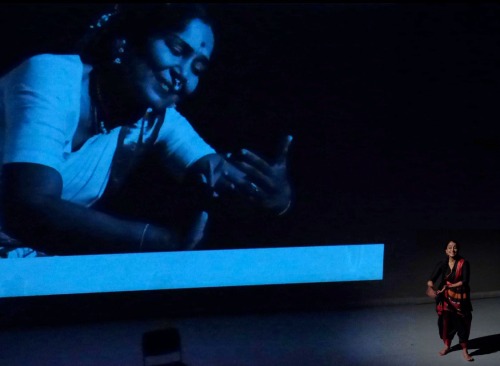
AL: What is dance for you?
RP: For me dance is theater, which is how I got into theater with Julie Taymor, because Indian dance is an expression of your inner most being. Actually, it’s only recently that I realized I want to take the words out of the work I do because I think when you can speak with your heart through your body as I watched the people in the Horse’s Mouth, the ones who moved me most, were telling me something beyond the words. Those who moved me the least were the ones telling me how great they are, and I couldn’t even listen to them, because who their body was, was not someone I was very interested in. But it’s the ones who just came quietly and presented their being and their love of what they were doing, and the deep need for you to see how beautiful the work was, you have to have that. We’ve been taught to smile and say ‘aren’t I great’ but what are you actually saying?
AL: But I feel what you do to combine and tell stories is so amazing. I remember when you were part of the panel of dance critic association and you were talking about the relationship between words and movement and I was fascinated. I feel what you do is so powerful.
RP: So when I did theater work, I went hoping to be choreographer and ended up as the main character, wearing a 3 piece suit with long hair, speaking in the person of Thomas Mann, and the music was written by Elliot Goldenthall who was Julies partner, and they both encouraged me to use my voice. I said no, I’m magic when I don’t speak, and in that experience I discovered the magic of when I do speak and use my voice. I was the voice of many of Julie’s puppets. So then I became Kali, and I sing as Kali.
AL: Are you trained? I didn’t know that!
RP: I trained as a kid, in England. So Mommy sent me to ballet class but I didn’t have the feet, and then I took piano and the teacher of the ballet class had a best friend named Madame, and she was so taken by me a little dark skinned girl with big white eyes, that she said ‘oh I will give you lessons for free’. So I took lessons every Saturday. And I sang in the messiah youth chorus at the age of 10. So I have the musical training, I can read music.
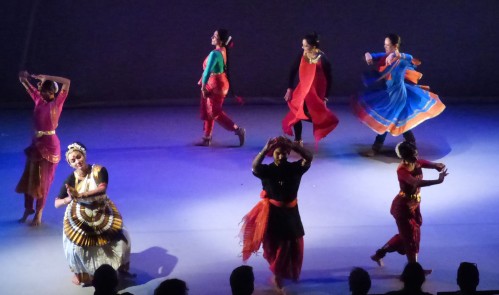
AL: Tell me more about Rajika as a choreographer
RP: Well I never said I was a choreographer because I’m not an artist.
AL: You’re not an artist?
RP: Well I didn’t think so, but I guess now I am. I didn’t think I had the creativity. When I just decided, wouldn’t it be fun to do a work without the dancers. I started doing collaborations, and working in post-modern.
AL: But how do you use traditions? Can you talk about this a little bit more?
RP: You know its structure and form. I am a structuralist. That’s what I learned when I studied with Dred Williams, she was absolutely brilliant. I was her first student, and some of the people did not like me because she favored me. I was young and exuberant, fortunately one person who was there is still a friend. She was telling me when she saw my first work, she said ‘this is Rajikas thesis and its true in a way because I took the structure and the idea of postmodern, what you do with multiple bodies, and answered those questions.
AL: How did you feel about the reception of your work?
RP: When I did it, it’s funny I think the ideas are embedded, so when I did the first piece, I did it at some festival. So I remember one or two of the older dancers, they were big divas in India and they said ‘eh it’s okay’ because what I was doing, the principle of it, frankly is embedded, nothing new. I just made it happen because I know what postmodern is, and I knew new music. Not that much, but we go to a lot of new music and new opera. I can really hear Phillip Glass, I hear the amazing things he’s doing. And I tell you, that autobiography of his, I had all this work to do, and I wanted to read the whole thing at once, but I didn’t I read 30 pages at a time. He’s a Buddhist, and everything he wrote was about something else. He took you through his life. I want to write a biography like that, that talks about this, gives you an idea what it was like to be in London at the time as an Indian, as a ballerina. Not about me, but gives you a sense of the social and artistic background. He’s out of his mind of course, but I think I would love to recapture that and re-learn who was there at the time. To me I think that is the story that is interesting, I am just the thread. I can now hear Phillip.

AL: Who is Rajika as a curator? What are you looking for? How do you feel? For me, it was an amazing evening. What is your role and responsibility?
RP: As my creation, I have to say I call it conversations with Shiva. She came to me and said, what is your idea? I’ll help with the music but I have to know what it’s about. And I said I don’t know. I realized I’m channeling. I never thought I’d say that. I want to talk about irascible men. All my stories are about these men, and it is about the heat they didn’t know they had. So as a curator that came to me. I learned the word curator from Anita. She is much younger than I am but she is an older sister to me when it comes to learning. I watched how she curated the festival that later became the festival that brought new works, and innovative works. She talked about curation, and I had never heard about that so I was intrigued. She said, people have to learn. That’s the eye she has. Then in 2008, I was asked to help curate the dance festival. They brought on board this young woman. She walks in and I realize this young woman who is about 30 years younger than I, taught me how to curate. And I had to admit I said a lot of loud mouth things about her, but at least I had the guts to say ‘oops!’ I helped her with the bios, looking at the work, and now actually I have become a master curator.
AL: This is also something new for the Horse’s Mouth -the first evening with Indian dance. They didn’t do ethnic dance before.
RP: Well they’ve done tap dancing before. And then they’ve done Ted Shawn, and then they did specific people. But you know I’ve been in 10 Horses’ Mouths. I can even say I danced Jacobs Pillow because last minute someone called out and they needed me. I had tickets to Lincoln center and I said to my husband I do want to go to the opera but this is amazing. Hopped on an overnight bus, grabbed my Sari, and was magically in the mecca. New York is the mecca in one sense, but Jacobs Pillow is a wonderland for dance. So when they asked me to curate this, I knew, and then they said you must open the show. They knew I was a dance story teller and I should do a story. And I thought, I am strong and everything, but I’m nothing. The person I would like to have on that stage is Balasaraswati. She came here in 1962, comes from a temple family. They are musicians and dancers. They were dedicated to the biggest temple of Shiva. She is a beacon, she brings that knowledge of depth, of being in the space, knowing your music, knowing your lyrics, and improvising everything, including rhythm on stage -I’ve seen her do it, in 1965 at the 92nd street Y. She gave her brother a look and then she started. Her feet were like lightning. And then she did her song, and the mic came down in the middle of the stage. Now that her mother had died, she was the only one to sing. That is a quintessential dancer. And she left her legacy here, her daughter married one of her brother’s best students, Doug Knight who wrote the book on her, and they produced a son. So her legacy is in America. So her grandson came to me and said, you do know that on the 13th of May we start the 99th year of Balasaraswati and we’re doing events all over the world. This is what I mean by channeling and listening. Shiva told me. That’s why I was chosen by Tina to do this at this time.
AL: The whole show was so emotional. I brought a friend and she was so emotional.
RP: Tina Kroll and Jamie Cunningham. He’s a director. Tina Croll is the most luminous person I know. They conceived this in 1998. They have brought the community together. This show, what I take away from it is what I saw backstage. These kids were taking photos of each other, looking after each other. Everyone wanted to look after each other. It was all giving, giving, giving.
AL: That’s amazing, and as an audience member, we feel that community.
RP: And we are all solo dancers. We were told not to look downstage, look at each other. Those who did, were the ones who got the most out of it. Only when you’re telling your story do you look at the audience. There’s a sense of a timeline to eternity.
AL: Well that is the power of dance. Especially in the times we live in. Now dance is all about self-indulgence, and we forgot why we started dancing.
RP: Yesterday I went to see the Limon Company at the Joyce and I had done a festival with Louis Solino, and I took class with him in Costa Rica. For a long time I hadn’t seen the Limon company. I loved seeing it because I really understood the groundedness.
AL: Is there anything you’d like to say? Anything you would like to share about Rajika?
RP: I have had a bad shoulder, I discovered is congenital from all the typing and from getting older. I actually have two newsletters to write tonight. I’ve presented with World Music Institute, and also with World Flamenco. I think it’s really the realization that there is no such thing as authentic, things change constantly. So I think it’s about communication. I could have gone into film, a lot of people asked me to. I think I’m a live performer. There is nothing like communicating with a live audience on stage. I watch all those film stars, I’m a member of SAAG. I adore Helen Mirren and Meryl Streep, I envy them in one sense, but they got where they did because they’re stage performers. There is nothing like it.
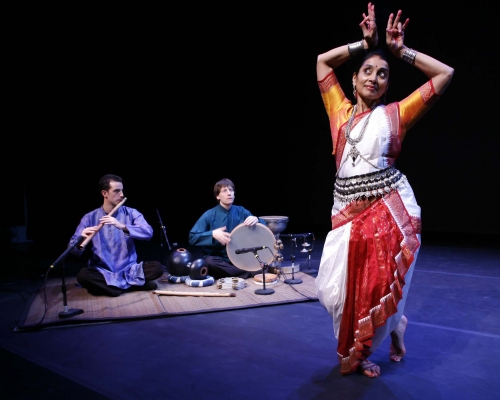 DeviMalika: A garland of danced and sung stories of the feminine divine in India (2008, Duke on 42nd St, earlier version 2005 Commissioned by the Rubin Museum of Art). Rajika with Eric Fraser and Shane Shanahan as ‘Krishna’ in RADHA
DeviMalika: A garland of danced and sung stories of the feminine divine in India (2008, Duke on 42nd St, earlier version 2005 Commissioned by the Rubin Museum of Art). Rajika with Eric Fraser and Shane Shanahan as ‘Krishna’ in RADHA
RAJIKA PURI (dancer/actor/choreographer/lecturer/curator). Trained since childhood in two forms of Indian dance – Bharatanatyam & Odissi – Rajika toured for many years all over Europe, the US, South and Central America, and her native India, giving solo recitals – including a Command Performance for the President of Mexico. After playing “Narrator/Goddess Kali/voice of several puppets’ in a Lincoln Center production directed by Julie Taymor, she developed a form of danced storytelling in which she sings and chants in Sanskrit and narrates an English text as she dances. Evening-length works, like TAPASYA: Ascetic Power and Tales of the Ganges (2009), unfold a theme through choreographed dances set to ‘new’ Indian music and danced stories from Indian myth. DEVI-MALIKA: a garland of danced stories on the feminine divine in India was presented Off-Broadway (2008). CONVERSATIONS WITH SHIVA: Bharatanatyam Unwrapped (2007) explores the traditional Bharatanatyam solo repertoire as group choreography with a ‘post-modern’ take.
Rajika also works with different kinds of non-Indian music like Bach, American Song, and flamenco (Asia Society, NY, Museo del Baile Flamenco, Seville, Joyce SoHo, NY, and on tour in India). She co-composes the music for her productions, including ELENI OF SPARTA on the life of ‘Helen of Troy’, in which she sings in ancient Greek!
An MA in the social-anthropological analysis of meaning in movement (NYU), Rajika writes and lectures on Indian dance-theatre. Her “Ted India” talk on “The Importance of Myth” included two danced stories: Savitri and Ganga (2011). Critics often quote her pre-performance onstage slide lectures – for the Metropolitan and Cleveland Museums of Art, and for World Music Institute’s annual Dancing the Gods Festival. She also co-curates the latter festival and Indo-American Arts Council’s Erasing Borders Festival. Rajika is sole curator for Tina Croll and Jamie Cunningham’s FROM THE HORSES MOUTH celebrates INDIAN DANCE in AMERICA. http://www.rajikapuri.com
